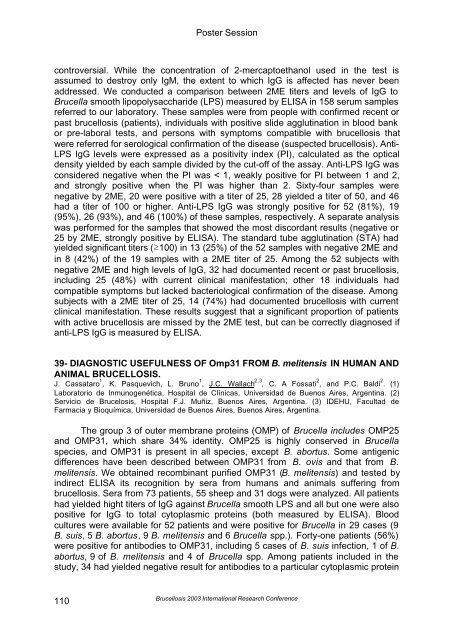Brucellosis 2003 proceedings - PHIDIAS
Brucellosis 2003 proceedings - PHIDIAS
Brucellosis 2003 proceedings - PHIDIAS
You also want an ePaper? Increase the reach of your titles
YUMPU automatically turns print PDFs into web optimized ePapers that Google loves.
Poster Session<br />
controversial. While the concentration of 2-mercaptoethanol used in the test is<br />
assumed to destroy only IgM, the extent to which IgG is affected has never been<br />
addressed. We conducted a comparison between 2ME titers and levels of IgG to<br />
Brucella smooth lipopolysaccharide (LPS) measured by ELISA in 158 serum samples<br />
referred to our laboratory. These samples were from people with confirmed recent or<br />
past brucellosis (patients), individuals with positive slide agglutination in blood bank<br />
or pre-laboral tests, and persons with symptoms compatible with brucellosis that<br />
were referred for serological confirmation of the disease (suspected brucellosis). Anti-<br />
LPS IgG levels were expressed as a positivity index (PI), calculated as the optical<br />
density yielded by each sample divided by the cut-off of the assay. Anti-LPS IgG was<br />
considered negative when the PI was < 1, weakly positive for PI between 1 and 2,<br />
and strongly positive when the PI was higher than 2. Sixty-four samples were<br />
negative by 2ME, 20 were positive with a titer of 25, 28 yielded a titer of 50, and 46<br />
had a titer of 100 or higher. Anti-LPS IgG was strongly positive for 52 (81%), 19<br />
(95%), 26 (93%), and 46 (100%) of these samples, respectively. A separate analysis<br />
was performed for the samples that showed the most discordant results (negative or<br />
25 by 2ME, strongly positive by ELISA). The standard tube agglutination (STA) had<br />
yielded significant titers (ò100) in 13 (25%) of the 52 samples with negative 2ME and<br />
in 8 (42%) of the 19 samples with a 2ME titer of 25. Among the 52 subjects with<br />
negative 2ME and high levels of IgG, 32 had documented recent or past brucellosis,<br />
including 25 (48%) with current clinical manifestation; other 18 individuals had<br />
compatible symptoms but lacked bacteriological confirmation of the disease. Among<br />
subjects with a 2ME titer of 25, 14 (74%) had documented brucellosis with current<br />
clinical manifestation. These results suggest that a significant proportion of patients<br />
with active brucellosis are missed by the 2ME test, but can be correctly diagnosed if<br />
anti-LPS IgG is measured by ELISA.<br />
39- DIAGNOSTIC USEFULNESS OF Omp31 FROM B. melitensis IN HUMAN AND<br />
ANIMAL BRUCELLOSIS.<br />
J. Cassataro 1 , K. Pasquevich, L. Bruno 1 , J.C. Wallach 2,3 , C. A Fossati 2 , and P.C. Baldi 2 . (1)<br />
Laboratorio de Inmunogenética, Hospital de Clínicas, Universidad de Buenos Aires, Argentina. (2)<br />
Servicio de Brucelosis, Hospital F.J. Muñiz, Buenos Aires, Argentina. (3) IDEHU, Facultad de<br />
Farmacia y Bioquímica, Universidad de Buenos Aires, Buenos Aires, Argentina.<br />
The group 3 of outer membrane proteins (OMP) of Brucella includes OMP25<br />
and OMP31, which share 34% identity. OMP25 is highly conserved in Brucella<br />
species, and OMP31 is present in all species, except B. abortus. Some antigenic<br />
differences have been described between OMP31 from B. ovis and that from B.<br />
melitensis. We obtained recombinant purified OMP31 (B. melitensis) and tested by<br />
indirect ELISA its recognition by sera from humans and animals suffering from<br />
brucellosis. Sera from 73 patients, 55 sheep and 31 dogs were analyzed. All patients<br />
had yielded hight titers of IgG against Brucella smooth LPS and all but one were also<br />
positive for IgG to total cytoplasmic proteins (both measured by ELISA). Blood<br />
cultures were available for 52 patients and were positive for Brucella in 29 cases (9<br />
B. suis, 5 B. abortus, 9 B. melitensis and 6 Brucella spp.). Forty-one patients (56%)<br />
were positive for antibodies to OMP31, including 5 cases of B. suis infection, 1 of B.<br />
abortus, 9 of B. melitensis and 4 of Brucella spp. Among patients included in the<br />
study, 34 had yielded negative result for antibodies to a particular cytoplasmic protein<br />
110<br />
<strong>Brucellosis</strong> <strong>2003</strong> International Research Conference
















